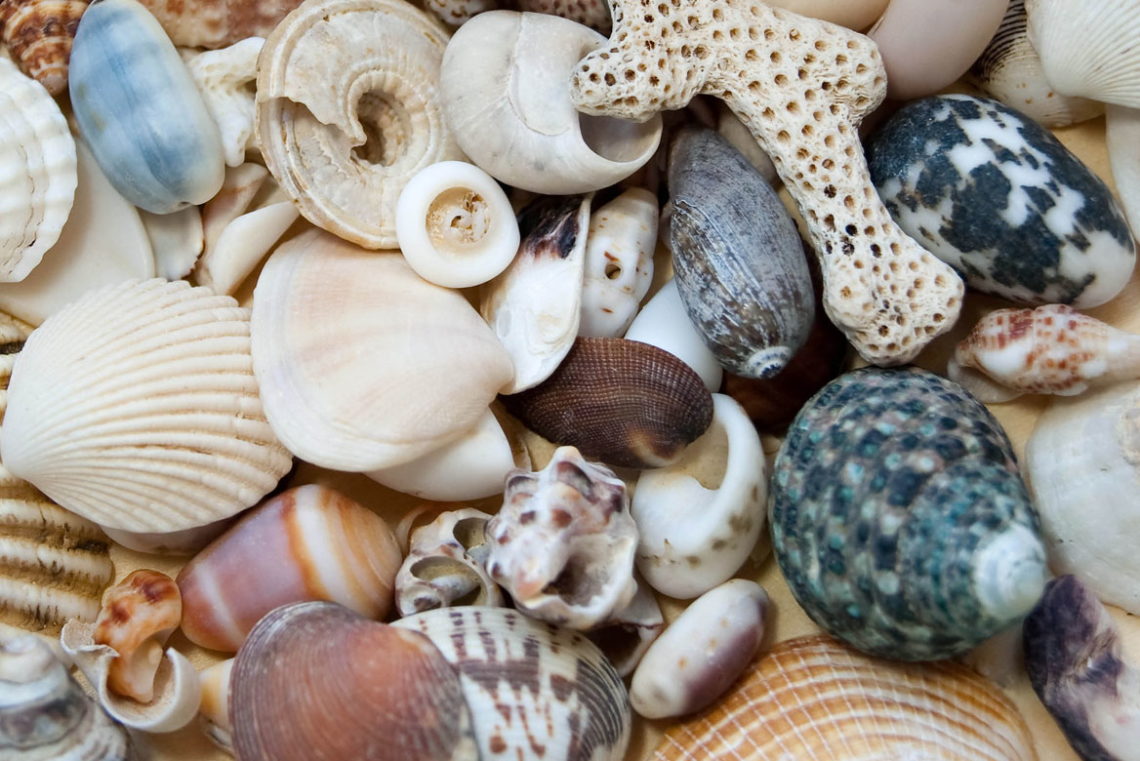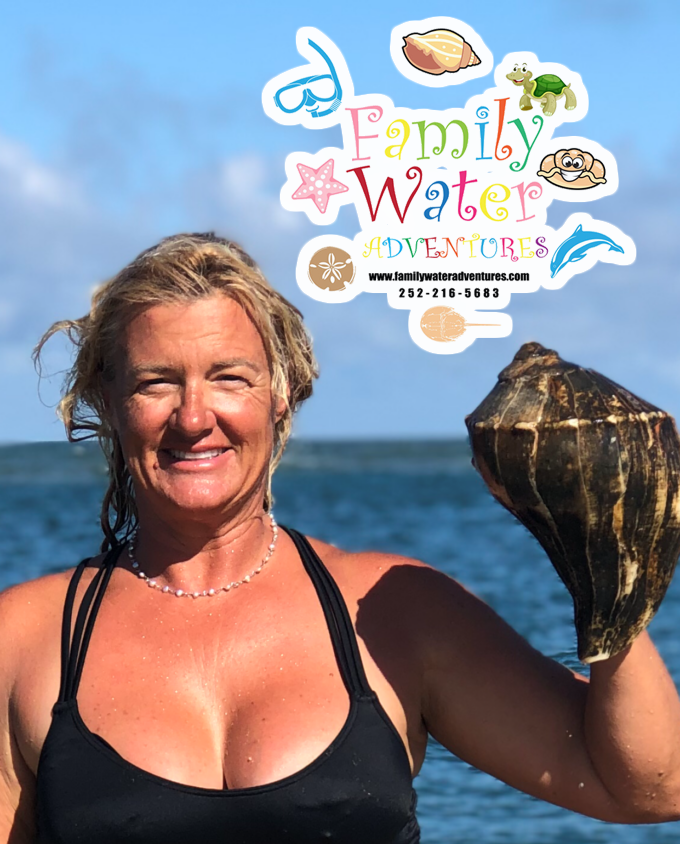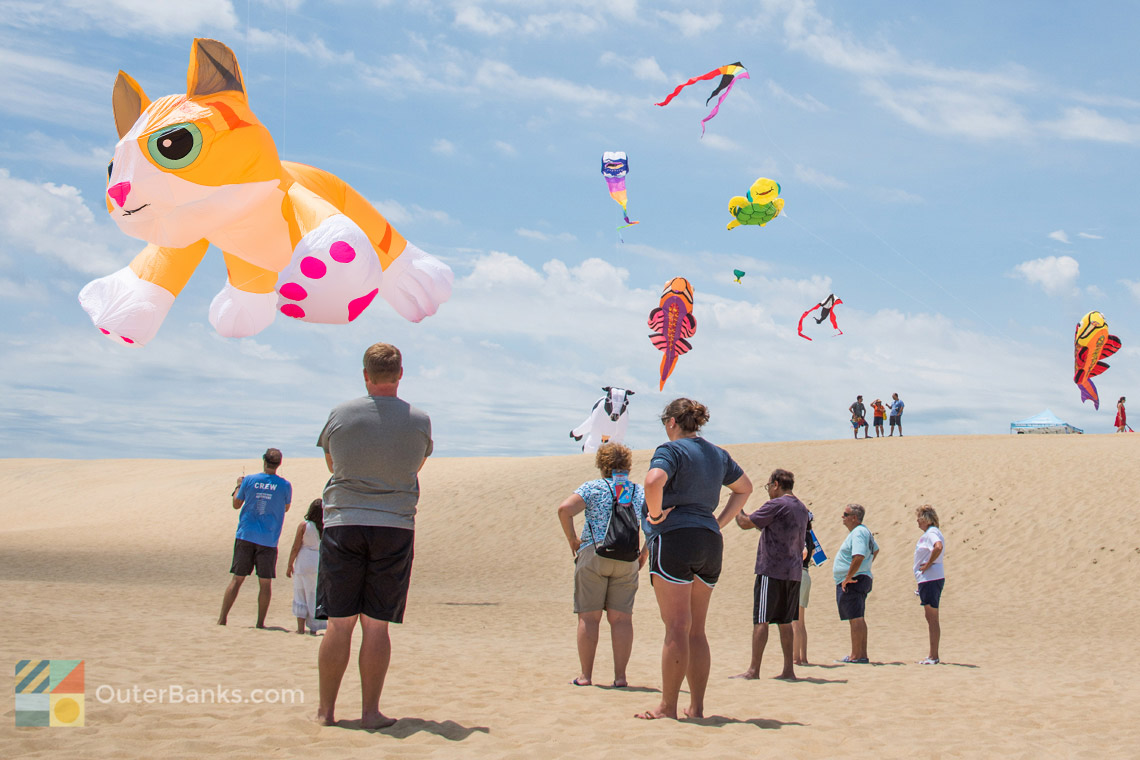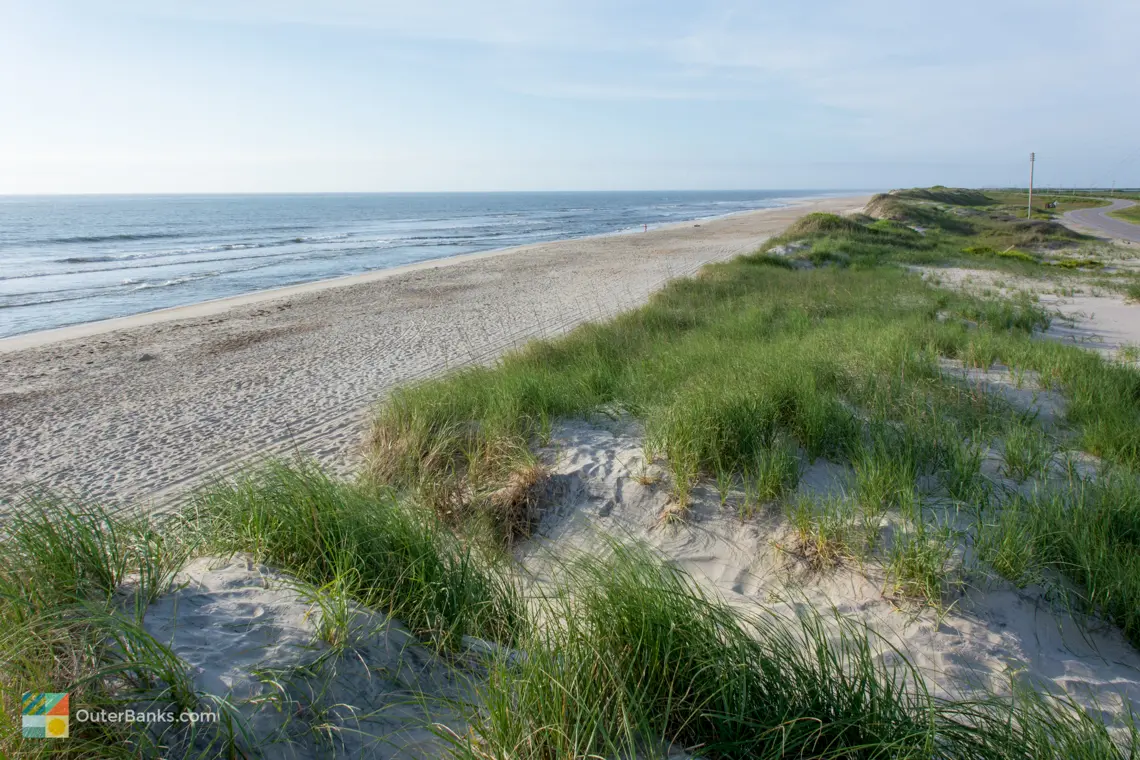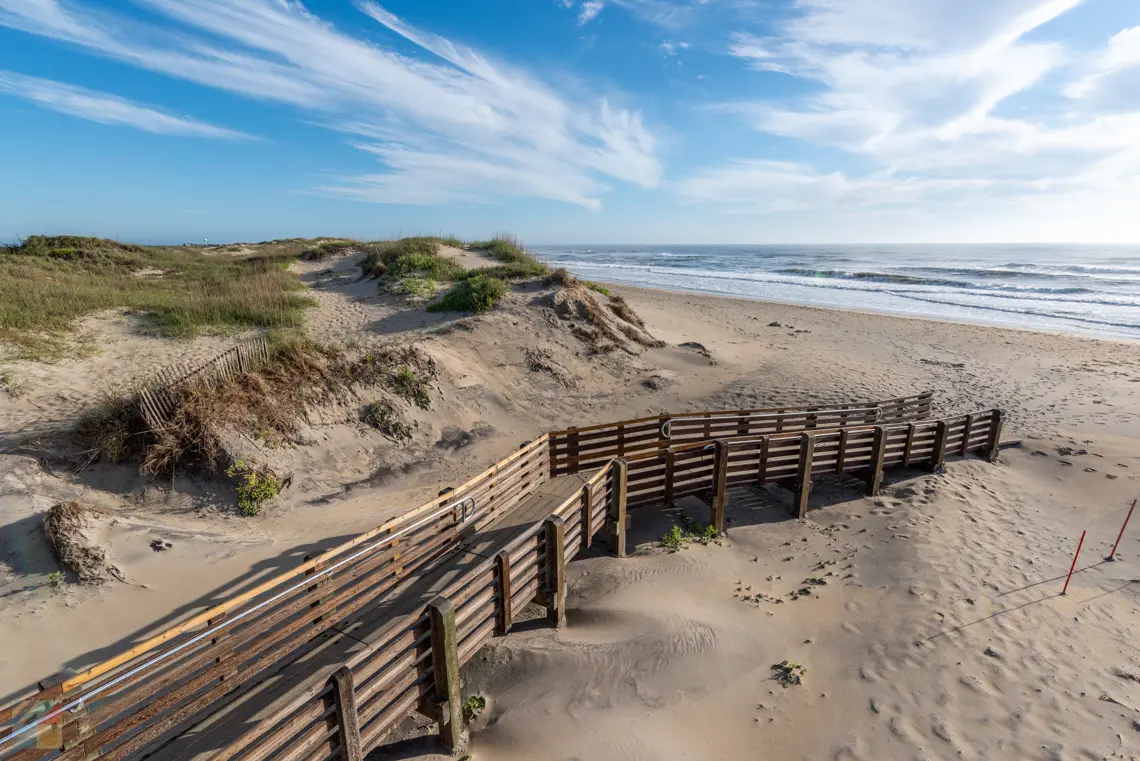Go shelling with the experts at Family Water Adventures! Family Water Adventures' seven expert captains have been sharing their deep knowledge of local creatures, fish, and shells since 2007. In addition to shelling excursions, they offer snorkeling, paddle boarding, Sand dollars, eco tours & light fishing. Guests rate Family Water Adventures 5 stars on Google reviews! Book your guided family adventure trip from Hatteras Island and visit multiple tidal islands where your family can find snorkeling & fishing opportunities, shelling, hermit crabs, shark teeth, unique bird species, and sea glass. All without the crowds, chaos, or set itinerary. Bring a cooler for your snacks and bevereges. Shell bags are provided. If you want to fish, bait and tackle are provided. No need for a license on our tours! Trips leave daily from Hatteras Landing Marina. 8am-12pm and 12pm - 4pm, 7 days a week. Visit Family Water Adventures website or call 252-216-5683 to reserve your adventure today!
Shelling Guide Sections:
- Types of shells in the OBX
- Where and how to find shells
- Best OBX shelling beaches
- Shelling tips and tricks
If you know where to look, the Outer Banks can be a beachcomber's paradise. With miles of shoreline to explore, hidden beaches that are relatively untouched, and literally piles of shells washing up on the beaches after a storm, shelling on the OBX beaches is simply a matter of timing and area expertise.
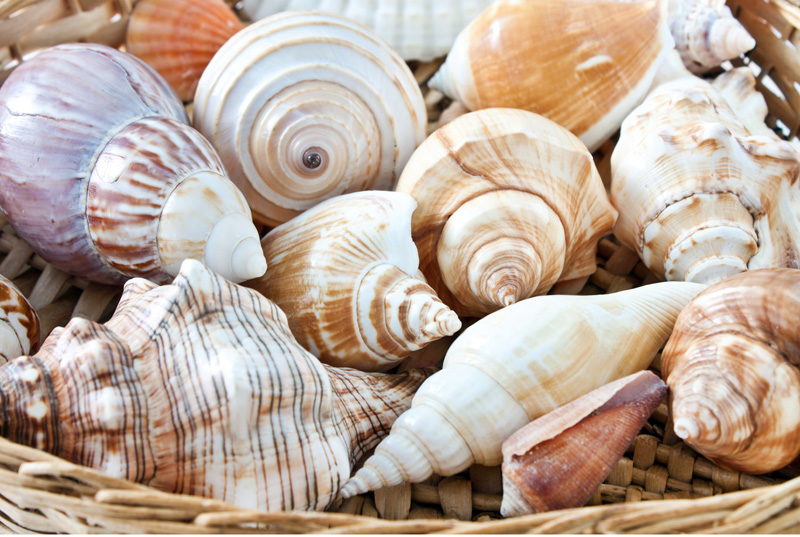
That's not to say that there isn't a little bit of luck involved in any good beachcombing expedition. Some lucky strollers may happen upon a freshly washed up whelk or even a Scotch Bonnet without much effort, and sometimes the best of beachcombers can be skunked during an extensive shelling trip.
But the key to successful shelling is to never stop looking. Just because one beach trip isn't fruitful doesn't mean the next one won't be as well, and if the only thing a beachcomber brings back from a beach trip is a revitalized spirit and a suntan, that's not a shabby day on the Outer Banks at all.
The Outer Banks is unique in that the miles of barrier islands, separated by three inlets, collectively make up a variety of different beaches, and therefore, a variety of different shell habitats. The "north" facing beaches located above Cape Point in Buxton generally attract colder water shells that wash up from New England to North Carolina, while the "south" facing beaches, or the beaches located South of Hatteras Island's hook back towards the mainland (at Cape Point), can attract shells that are found from North Carolina to Florida.
Added to this unique geography is the proximity to the two major East Coast currents, the Gulf Stream Current and the Labrador Current, which can also assist in carrying large migrating fish, marine life, and even seashells to the islands' shores.
In essence, there is virtually no shortage of different varieties of shells you can find on the Outer Banks. Because of this, the area is well-known by shell hunters all along the East Coast, and regions of the OBX have even appeared on national "Best Shelling Beaches" lists. For example, Ocracoke Island was ranked the #2 best shelling beach in the country on Coastal Living magazine's list, second only to the seashell Mecca, Sanibel Island, FL.
That being said, there are a few varieties in particular that beachcombers should be on the lookout for. These shells are prized for their rarity, their beauty, or both, and are considered exceptional finds on the Outer Banks.
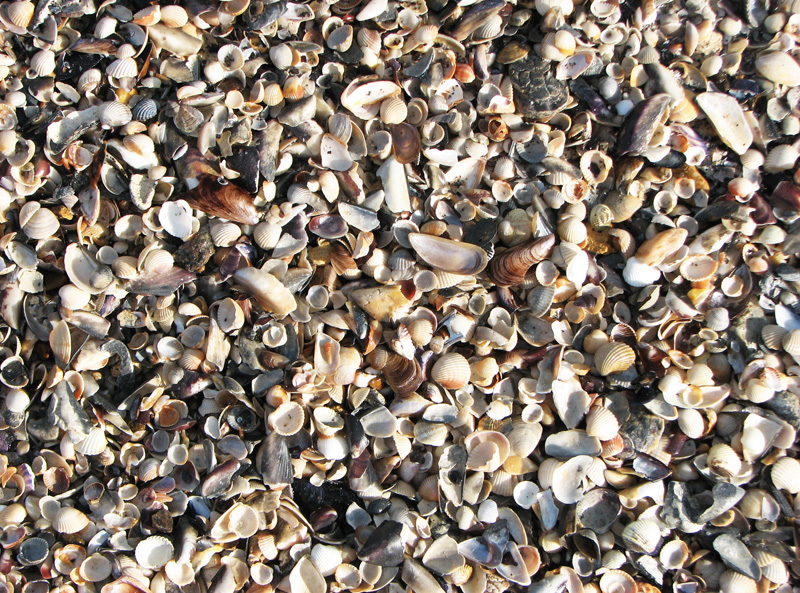
Types of Shells on the Outer Banks
The Scotch Bonnet is the official North Carolina State shell, and as such, beachcombers may assume that they are easy to find all along the Outer Banks. Unfortunately this couldn't be further from the truth. The Scotch Bonnet is surprisingly rare, and is arguably one of the best finds on the Outer Banks. A conical shell with a fat middle section and a stark white color with small, brown specks covering the body, the Scotch Bonnet is a simply beautiful shell to behold. Averaging 2" long, it's not a very big find, but it certainly stands out in a shell pile.
The Queen Helmet Conch is a close second on the Outer Banks beachcomber's MVP list, and could be considered a cross between a whelk and a Scotch Bonnet. The helmet conch is a fat conical shell that is distinctive because of its large opening, with bring pink or red lips which are usually lined with small hard "teeth." When most folks think of conchs, this is the shell they have in mind, and the helmet conch can be a large, heavy find, clocking in at 12" long or more. A gorgeous shell that is found sparingly on the south facing beaches, the helmet conch is truly an Outer Banks treasure.
Whelks generally produce the most confusion among new Outer Banks beachcombers, as they are commonly and mistakenly referred to as "conchs." They certainly have many similarities to the Florida conchs, with conical shapes, wide openings, and fat spirals that line the top of the shell, but whelks are much more common on the Outer Banks and the northern East Coast beaches.
Found literally everywhere, from Portsmouth Island to Carova, whelks actually come in three different varieties: the lightning whelk which is generally the largest at 14" long or more, the knobbed whelk which is literally a mirror of the lightning whelk as it has a "right-sided" opening instead of a left oriented one, and the channeled whelk, which has deep channeled spirals instead of the spiny spirals that the knobbed and lightning whelks possess. Whelks can range widely in colors and sizes, and beachcombers can find a brightly hued 2" whelk, (a young variety) or even a 14-16" giant shell, which is a showpiece on any mantel.
Olive shells are another beloved find. Another conical variety, olive shells resemble long, pointed tubes with a small number of spirals at the top, and a long opening that has shades of pink or even dark purple on the inside. A fresh olive shell, (or one whose color hasn't been lessened by battering ocean waves and sand), can be patterned with hundreds of tiny triangles and abstract designs, making these shells absolutely gorgeous finds. At just 2-3" long at most, the olive shell is a delicate find that Outer Banks beachcombers love to uncover.
Other popular shells on the Outer Banks beach scene that are conical in nature include the auger, the oyster driller, the periwinkle, the moon snail and the sundial. Augers are tiny, with long conical shapes and spirals that encompass the entire length of their bodies. Oyster drillers look on the surface like miniature whelks, but their bodies are long and narrow, and the oyster driller rarely gets over a 1" in size.
Periwinkles are also small finds, rarely reaching over an 1" in size, and have fat conical bodies that taper off to a small point of spirals, while sundials are one of the most beautiful shells on this list, and resemble a Nautica shell, with a flat, circular shape, and spirals running all the way from the perimeter-located mouth to the center of the shell. Moon snails are similar to the sundial, in that their circular shape contains a mouth opening, and spirals that wind all the way into the center of the shell. However, the moon snail is one of the more common shells on the Outer Banks, and while the sundial rarely gets larger than 3", a moon snail can be 5" or more. They are also generally "fatter," with a pale gray exterior and a bright blue spot near the mouth's opening. This feature has given the moon snail its common Outer Banks name, the Shark Eye.
All of the above conical shells are somewhat common, and are best found in large shell beds that wash up with regularity around the beaches. A little stopping and digging may be involved to uncover them, but all of these species are gorgeous additions to any shell collection.
One of the most common shells on the Outer Banks is the coquina clam, and in fact, there is an entire stretch of beach named after this tiny shell, located just north of Nags Head. The coquina is a gorgeous find, and like a snowflake, every single one is different. The coquina comes in a spectrum of colors, from pale purples and pinks to bright yellows and oranges, and can even feature stripes or interesting color combinations. A coquina shell bed is always the most colorful sight on the beach, and though only 1" long at the most, coquinas are arguably the most striking of the Outer Banks seashells.
Beachcombers can also expect to see a number of mollusks and clams along the beaches, which are bi-valve shells, (or shells with two mirroring sides), and which can wash up with both sides intact, or more commonly, with only one side floating along the shore. The calico and bay scallops are the most popular scallop shells on the Outer Banks, and can be a gorgeous finds, ranging in hues of white, gray, pink, and even yellow, and often containing speckled patterns or lines spanning their shells.
The clams along the Outer Banks are often giant specimens, better known as quahogs. Though generally common, many beachcombers love a good quahog as these shells easily double as a soap dish, ash tray, or simply a display container to hold other, smaller shells. Oysters also commonly wash up, and while their exterior is generally knobby and gray, the interior is lined with an iridescent coasting making them simply beautiful. Occasionally, a lucky beachcomber may even stumble upon a pen shell. A pen shell is also a bivalve, with a delicate long and iridescent fan-shaped body, but a glossy interior that is simply striking.
Regardless of what shells you uncover, scallops, clams and even pen shells are great multi-purpose shells that can be used for crafts, containers, or simple trinkets and reminders of a great day at the beach.
After a few shelling trips, beachcombers may notice that not every shell, despite being the same species, looks remotely the same. Variations can occur in size, color, and even overall structure, and there are a number of reasons for these discrepancies.
The coloring of a seashell can be affected by both the age of the shell, as well as the environment it came from. Shells that were submerged in ocean bottoms with tar will often turn a grayish color, or have sections that are much darker and almost black. Older shells tend to turn white as they age, with ancient shells, (or shells that 1,000 years old or more), generally being a stark white all the way through.
As for size, it all depends on both the age and genre of the original shell resident. As a whole, female specimens are generally larger, and older shells are of course much larger. While some shells have limited size variations, (like the Scotch Bonnet), others, like whelks, can vary by inches if not feet.
The actual structure of a shell is also affected by its living conditions, so to speak, before it was washed ashore. For example, a whelk that had been stranded in the ocean for some time, and suffered exfoliation due to both sand and ocean waves, will generally have smooth, almost non-existent knobs along the top of its' spiral. A "fresh" whelk, however, that has not suffered the same deterioration, will have sharper knobs, well-defined spirals, and much brighter and more distinctive coloring.
Obviously, there's no right way to judge a shell's worthiness, and avid Outer Banks collectors may have one species they prize, and another they simply pass by. But newcomers should certainly indulge and have fun, and simply collect the shells they find most appealing and attractive. The great thing about shelling is that it is not a competition, and shell hunters can simply pick up the ones that they find the most pretty, the most personally valuable, and the most satisfying.

Where and How to Find Shells
The great thing about shelling on the Outer Banks is that virtually every stretch of beach under the right conditions can turn into a honey hole for shell hunters.
The most important and least reliable factor into ensuring incredible shelling conditions is a good storm. A passing hurricane or nor'easter can leave thousands of picture-perfect shells in its wake. Generally, this happens at least a day after the storm has passed, when the ocean waves have calmed down, and buckets of shells have had an opportunity to wash up on the beaches in huge piles, just waiting for an intrepid shell hunter to root through and dig out the best pieces.
For most vacationers, however, planning an Outer Banks trip right after a storm has passed isn't feasible, so experienced shell hunters relay on other methods to increase their chances of scoring the best finds.
On popular shelling beaches, where a shoreline or shell pile may have been picked through many times over, try getting dirty and sifting through the seaweed. Generally, when good shells wash up, they are accompanied by piles of dark brown sea grasses and murky green seaweed, and most casual beachcombers overlook these grassy piles in favor of the more obvious finds along the shoreline.
This is a rookie mistake, as sometimes the best finds, especially for small delicate shells, can be found buried in the clusters of grass. The grass protects small finds from the battering waves as they come ashore, after all, and the chances of finding a Scotch Bonnet, an auger, or even a small whelk increase greatly amidst the heavy seaweed piles. Don't be afraid to get your hands dirty, and feel free to sift through with vigor. It's an old local wives tale that the grossest piles of seaweed are almost always home to the best shells on the Outer Banks.
Avid shell hunters may want to consider getting their feet wet too. Again, on popular beaches that have been picked over, sometimes the best finds are just off the shoreline, in the 1'-2' feet of water waiting by the ocean wash. This is especially true on beaches with shallow bottoms, and smaller waves, though even beaches with big drop-offs and waves crashing close to shore can have ankle deep shell piles just offshore, waiting to be discovered.
This type of shelling requires a very good eye and a quick reflex in order to scoop a good find out of the water before it is tumbled around by an incoming wave. That being said, a beachcomber can also be greatly aided by bringing along a small net to scoop out a section of shells from a submerged pile, and then sift through to see if there are any good finds.
The sound beaches are exceptional training grounds for this water-logged method of shell hunting, as the majority of shells on the soundside are located in the shallow, close-to-shore waters. Here, beachcombers may find periwinkles, clams, scallops, and ancient whelks or olive shells that are the signature bright white, and have been buried for hundreds if not thousands of years.
Shell hunters may also want to head to the inlets. The waters bordering the three inlets on the Outer Banks, specifically Oregon Inlet, Hatteras Inlet and Ocracoke Inlet, have the distinction of being close to both the open sound and ocean waters, and the deep currents rushing through generally produces a variety of finds along the perimeter of the inlets' borders.
Above all else, pay close attention to the tides. Shelling is always best right after a low tide, when the shells have just washed up on the beaches, and are easy to scoop up before the next high tide takes them back into the water. On popular beaches, early birds also have an advantage, as they can scout the beaches for shells left behind during the most recent nighttime high and low tides, which have been undiscovered by competing beachcombers.
Of course, a beachcomber can follow all the guidelines and tricks in the book, and sometimes leave the beach empty handed. The good news is that the Outer Banks is such an ever-changing network of barrier islands, with wind and ocean current variations occurring on a daily basis, that shelling conditions can change just as quickly as the weather. Be persistent, keep looking, and you'll surely be rewarded with hundreds of deep sea treasures.
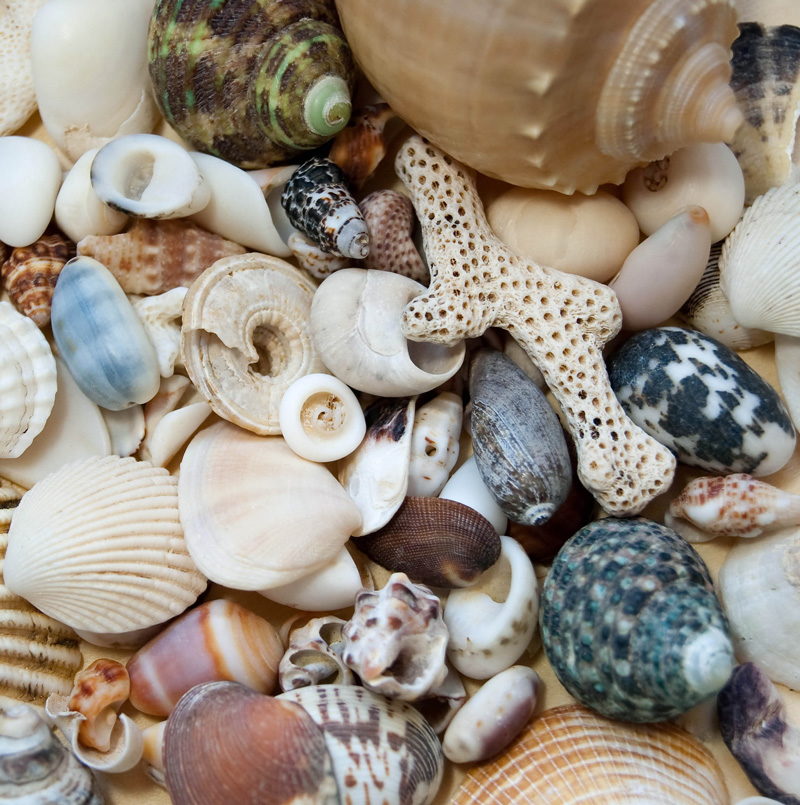
Best Shelling Beaches on the Outer Banks
On the Outer Banks, the best shelling beaches can change on a whim, with offshore sandbars forming and dissipating regularly, and ocean currents switching at a moment's notice.
A good rule of thumb is to look for beaches without a steep ocean floor "drop-off." This means that a swimmer can wade out into the ocean for a good 10-20 yards before losing their footing, and these types of beaches are generally common in both the northern Currituck areas and the southern Outer Banks beaches, south of Cape Point.
Many beachcombers also swear by those south facing beaches, where the more tropical and attractive species from Florida and the Caribbean can occasionally wash ashore.
With that being said, there are a few beaches on the Outer Banks that have always been popular with locals as exceptional shell hunting grounds, and newcomers that want to maximize their chances of finding a seaside treasure should consider hitting the following beaches first.
The 4WD beaches of Carova stand out both for their limited accessibility and the make-up of the shoreline. Generally, this stretch of beach has a shallow, gradually sloping ocean floor, which allows more delicate shells, like augers or olive shells, to wash up on the beach without any damage. This is combined with the fact that Carova is difficult to get to, leaving miles of beaches relatively untouched by beachcombers. The best time to go is during the shoulder and off-seasons, when tourism is at its lowest, and the beaches are generally untouched and ripe for the picking.
Beachcombers who can't resist a burst of color should head to Coquina Beach. This 4WD accessible beach located just south of Nags Head lives up to its name with miles of wide open shoreline and thousands of tiny coquina clams sprinkled along the sand from the oceanfront to the high tide line. For a spectacular show, head to this beach in the summer months, from late May until early September, and keep your eyes on the shoreline. During the summer season, piles of live coquinas frantically shimmy up to the surface for a minute or so before burrowing back under the sand, presenting a gorgeous display to casual beachgoers.
The local Outer Banks piers are also good spots for casual beachcombers to check out, as the pier structures create gradually shifting sand floors, and as a result, clusters of small shells can wash up along the shoreline. In this realm, virtually any pier will do for shell hunting - just be prepared to do a little hunting and scouting through a well picked-through shell pile.
One of the worst kept shelling secrets on the Outer Banks is South Beach, the southern-facing beach that is located adjacent to Cape Point in Buxton. Though only seasonally open, this beach intersects with the Labrador and Gulf Stream currents, and is located at the southern edge of Hatteras Island's "hook" towards the mainland, and as a result, produces some of the very best finds on all of the OBX. If you go, be sure and go early, especially after a storm when the beachcombers can come out in droves. January and February can be ideal hunting times, as South Beach is typically deserted, and yet the helmet conchs, whelks, and Scotch Bonnets still wash up on a regular basis.
The beaches of Frisco and Hatteras are also prime hunting grounds, as these beaches generally have a very shallow ocean floor, allowing shells to wash up without abrasions or damage from big ocean waves. A long walk along these beaches, especially right after low tide, can produce some incredible delicate finds, including Scotch Bonnets, augers, sundials, olive shells, and whelks, and all a shell hunter has to do to find them is to enjoy a long walk or a long ride along the beach.
As for Ocracoke Island, there's a reason why it has consistently appeared on best beaches lists across the country. The fantastic shoreline conditions, including a wide, shallow bottom and access to shells from as far south as Florida, coupled with its remote location, makes it a beachcombers dream. There's no one perfect beach here, just miles of shoreline to explore, and a great shell beach one day could shift a mile or two the next, depending on wind and water currents. The good news is that virtually every stretch of beach on Ocracoke Island could be home to dozens of Scotch Bonnets, whelks, olive shells, sand dollars, and even more exotic species like spiny murexes, pear whelks, or Florida fighting conchs. On Ocracoke Island, it's all a matter of being lucky enough to find the right beach at the right time.
As expert beachcombers know, the true shelling Mecca of the Outer Banks is located at its southern edge, just south of Ocracoke, on Portsmouth Island. Local and visiting beachcombers alike plan rugged weekend trips to this island solely because of its absolutely fantastic shelling.
Populated only by visiting fishermen, the beaches of Portsmouth Island offer the same exceptional shelling conditions as Ocracoke Island, but remain relatively untouched and undiscovered. In fact, a visitor who happens to head to the island right after a storm or in the early Spring season when the ferries first reopen for the year and begin making runs to and from the island, will find miles of whole whelks, Scotch Bonnets, sand dollars, and even helmet conchs and Florida fighting conchs.
Die-hard shell hunters should plan at least one trip to Portsmouth Island, either via the privately run ferry that leaves daily from Atlantic, NC, or via the Portsmouth Island ATV tour which departs from Ocracoke Harbor and provides visitors with a full morning or afternoon of discovering the historic Portsmouth Village as well as the shell-lined beaches. Vacationers who do not want to leave the Outer Banks without an incredible find should definitely plan to head to Portsmouth or Ocracoke Island for some of the best shelling the East Coast has to offer.
Regardless of where you shell, just remember that every beach changes with a switch in wind or current direction, or a passing storm, or a slight change in temperature. Half the fun in shelling on the Outer Banks is not knowing where the next great beachcombing beach will pop-up, and certainly enjoying a long walk along the coast with your eyes cast down towards the water is an enjoyable excursion all its own.
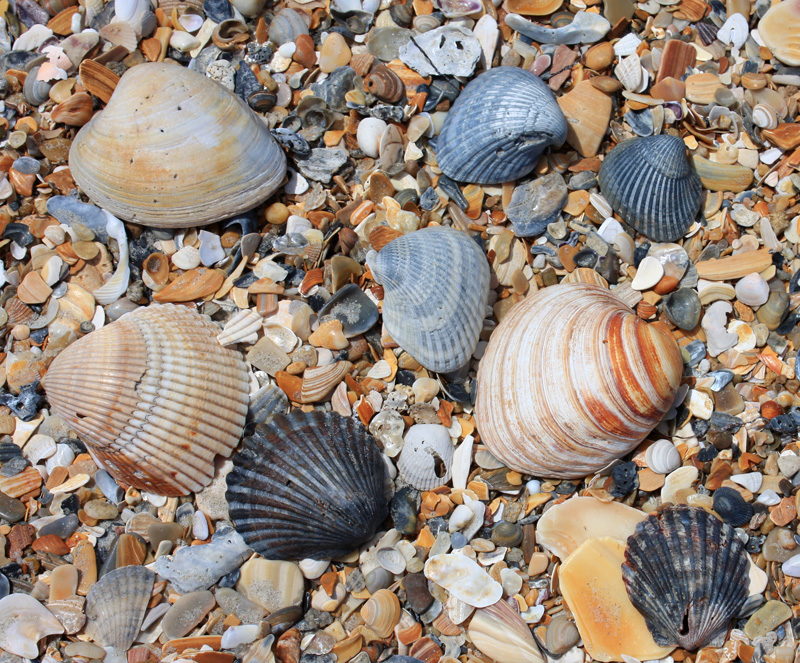
Tips and Tricks for Shelling on the Outer Banks
- If you can swing a last minute vacation, try visiting the Outer Banks a day or two after a storm. Once the waters have calmed down to their normal levels, piles of shells can wash up in droves along the shoreline. Take your time, and skim through these piles carefully. Chances are, there are a number of small finds, like oyster drillers, sundials or even Scotch Bonnets, which are hidden beneath the top layer of broken shell pieces.
- If you have a beach driving permit and a 4WD accessible vehicle, consider enjoying a morning of "Drive-by Shelling" along the Cape Hatteras National Seashore. In the shoulder and off-seasons, huge miles-wide portions of the Hatteras Island and Ocracoke Island shorelines are open to vehicles, and beachcombers in a hurry can simply skirt along the beach in their truck or Jeep and scope out patches of beach that are littered with clusters of shells. Then, it's simply a matter of hopping out of the truck and examining the finds. Arguably one of the most productive ways to beachcomb a large area, drive-by shelling is most effective during the off-season, well after the National Park Service seasonal beach closures have come to an end.
- Don't be afraid to look well off the beaten path for good shell finds. Remember that the entire Outer Banks sit on a cluster of slowly migrating islands, and even a walk through a maritime forest or along the soundside can produce some remarkable and ancient finds. Guests have even reported finding shells right under their vacation rental home, as the "fill" that is brought in during the initial construction to create a solid plot of land to build on is typically dredged right from the middle of the ocean.
- Don't forget that there are other treasures in addition to the standard collection of incredible shells that regularly wash up along the beaches. These treasure include sand dollars, which can range from a dark brown or green color with a fuzzy exterior to a bright white with the standard oval mark, to delicate egg cases for both manta rays and whelks, which are common beach finds in the spring and summertime.
- Ray egg cases are a glossy black and rectangular, with long black tendrils emerging from each of the four corners. Whelk egg cases consist of pale yellow half-dollar sized pockets which are connected together, creating a long, snake-like string of individual compartments. If you break one of these compartments open, you'll find dozens if not hundreds of microscopic whelks that are just barely visible by a human eye. While these finds may not make an appearance in your next craft project, they are nevertheless fascinating relics of the Outer Banks marine life, and a treasure all their own.
- If you're shelling on the soundside or by the local Outer Banks inlets, watch out for hermit crabs. Often, in these areas, a prized shell may already be occupied by a hermit crab, which is clear the second you try to grab a shell and it scuttles away. In order to preserve the hermit crabs that flock to the Outer Banks, go ahead and let these already-occupied shells go, and keep your eyes peeled for the next great find that hasn't already been claimed by a rival critter.
- Many shell hunters attest that the only way to ensure a "clean" shell is to boil it in water, and while this may be helpful for fresh finds that still may have residue along the edges, in most cases it is not necessary. In fact, a harsh boiling may even cause your Outer Banks shell to lose a bit of its color in the process. With this in mind, the best way to bring a newly found treasure home is to let it dry, shake out the sand, and simply pack it away in the suitcase. If nothing else, the faint salty aroma of your prized shell will simply serve as a reminder of a great Outer Banks vacation.
- A local rule of thumb for shelling is to always bring two bags: one for shells, and one for trash. If you spend a couple extra moments scooping up passing bottle caps or plastic that you find along the beach in addition to the shells, chances are the Shell Gods will reward you later on with some incredible finds.
Shelling is arguably one of the most popular activities on the Outer Banks, simply because it's an activity everyone can do, is completely free, and can be enjoyed on any stretch of shoreline on the ocean or soundside.
At its worst, shelling on the Outer Banks leads to a scenic long walk along the beach, and at its best, the shelling on the Outer Banks can produce some simply fantastic beach finds. On your next vacation, come discover why portions of the Outer Banks make regular appearances on national best shelling beaches lists. With a little luck, you may very well come home with a treasure that will have a place of honor in your home for years to come.
Go shelling with the experts at Family Water Adventures! Family Water Adventures' seven expert captains have been sharing their deep knowledge of local creatures, fish, and shells since 2007. In addition to shelling excursions, they offer snorkeling, paddle boarding, Sand dollars, eco tours & light fishing. Guests rate Family Water Adventures 5 stars on Google reviews! Book your guided family adventure trip from Hatteras Island and visit multiple tidal islands where your family can find snorkeling & fishing opportunities, shelling, hermit crabs, shark teeth, unique bird species, and sea glass. All without the crowds, chaos, or set itinerary. Bring a cooler for your snacks and bevereges. Shell bags are provided. If you want to fish, bait and tackle are provided. No need for a license on our tours! Trips leave daily from Hatteras Landing Marina. 8am-12pm and 12pm - 4pm, 7 days a week. Visit Family Water Adventures website or call 252-216-5683 to reserve your adventure today!
-
Avon Farmers Market
July 15th, 2025 9:00 AM - 1:00 PM -
Mustang Mornings at the Farm
July 16th, 2025 10:00 AM - 2:00 PM -
Surfing For Autism
July 17th, 2025 - July 19th, 2025
Welcome to Mike Dianna's Grill Room, home to the finest seafood, USDA prime beef, amazing live entertainment and more! Come have brunch or dinner with us in Corolla on the beautiful Outer Banks. Celebrating over 20 years in the Timbuck II Shopping Center in Corolla, Mike Dianna's Grill Room is owned and operated by a true Corolla local who grew up here and has lived in the area since 1984.
Explore Hatteras Island at its natural best with a visit to the Pea Island National Wildlife Refuge. Covering 13 miles of Cape Hatteras National Seashore land, this attraction is hard to miss, although there aren't many giant signs, hotels or businesses to point the way. Instead, visitors will find a completely undeveloped parcel of land, that's well-stocked with gorgeous views and serene nature trails that are ideal for off-the-beaten path excursions.
The Currituck Beach Lighthouse, located in the heart of Corolla, borders the historic Whalehead in Historic Corolla and still functions as a guide for passing mariners. At 162' feet tall, the lighthouse's First Order Fresnel light, (the largest size available for American lighthouses), can be seen for 18 nautical miles as the light rotates in 20 second increments.
Located just south of Nags Head, Coquina Beach is a refreshingly undeveloped stretch of shoreline that's close to the central Outer Banks towns of Kill Devil Hills, Nags Head, and Kitty Hawk, but feels like it's miles away.

